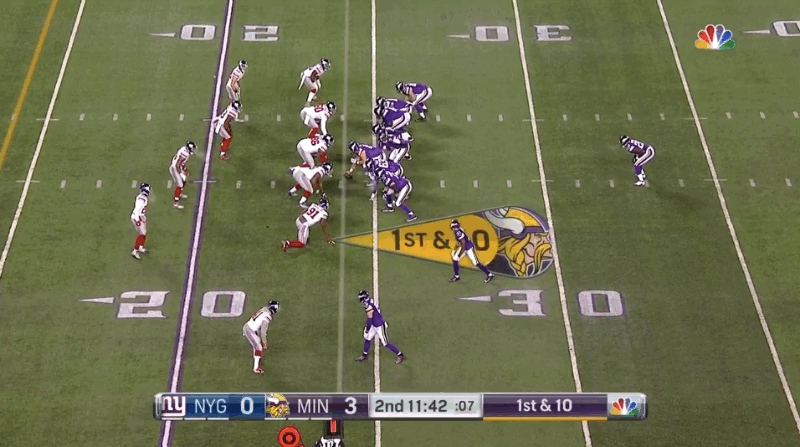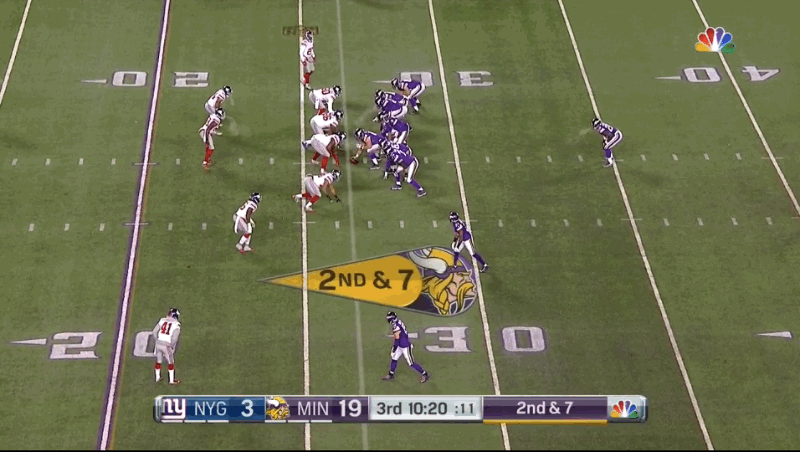Poll of the Week: Opening Up the Vikings’ Playbook

Adrian Peterson lines up eight yards behind Teddy Bridgewater, eyes up, feet planted, ready to explode into the wall of defensive linemen waiting for him. It’s a position he’s comfortable in, and one he’s been successful in his entire career. Of his 2,362 career rushing attempts, 98 percent (2,241) have come when the quarterback is under center. On those carries, he’s rushed for 11,143 yards — five yards per carry — and scored 94 of his 96 career rushing touchdowns.
That trend’s continued this year, his first full season back since missing nearly every game in 2014. Through 15 games in 2015, he’s rushed the ball 272 times with Bridgewater (and Shaun Hill) under center. Those carries have helped propel him to the top of the league’s rushing standings, with 1,362 of his 1,418 yards coming in such situations. It’s a formula that’s pushed the Vikings’ offense near the top of the rushing yardage standings, but one that’s proven frustrating at times.
Before his 104-yard performance against the New York Giants last Sunday, Peterson had failed to eclipse the 100-yard mark in the three previous games. The Vikings lost two of those contests by forcing the ball to Peterson on first and second down, putting Bridgewater in third-and-long situations far too often. That’s been the case in each of the Vikings’ five losses this season; rely too heavily on Peterson despite a failure to produce early, and the offense will flounder. Play-action passes are successful when a defense commits to stopping the run. If Peterson isn’t producing on early downs, linebackers and safeties won’t bite when Bridgewater fakes the handoff to his running back. Simply lined up behind Bridgewater, Peterson is a threat, but that threat can only become a reality if the defense isn’t completely honed in on No. 28.
Fortunately, offensive coordinator Norv Turner’s discovered a new weapon — one that can distract defenses from Peterson — in his loaded arsenal; second-year running back Jerick McKinnon.
In his past two games, McKinnon has looked like the change-of-pace back the Vikings thought they’d drafted in 2014. By lining McKinnon up all over the field, even pairing him with Peterson, the Vikings have been able to create big play opportunities in the running and the passing game. Last week, McKinnon caught four passes for 76 yards and a touchdown, and against the Giants, he rushed seven times for 89 yards and two touchdowns.
His sudden burst of production should be a lesson for Turner moving forward — find ways to get McKinnon on the field, on the field at the same time as Peterson, and on the field with the football in his hands. When asked about McKinnon after the game, head coach Mike Zimmer had nothing but praise for the explosive back. “Jerick is a good football player, and you see the explosiveness that he has,” he said. “This is a guy that gives a little bit of juice in a lot of different areas. I really like him. He’s played really well the last couple of weeks.”
In Week 15, he played 19 offensive snaps, and on Sunday Night, he played 14 snaps. Although he’s been on the field for less than 50 percent of the team’s offensive plays the past two games, McKinnon’s made the most of his opportunities. He did the same last year, starting six of 11 games as a rookie in place of Adrian Peterson. His season was cut short by a back injury that required surgery, but McKinnon eclipsed 100 yards twice and led the team with a 4.8 yard-per-carry average, per Brian Murphy of the Pioneer Press.
Given his talent, proven production, and the sudden jolt of energy he’s injected into Minnesota’s offense, is it time to give McKinnon more time on the field? A look at two plays from Sunday night’s game show how the Vikings can begin to use him more frequently:
Play No. One — Free McKinnon
The Vikings line up in 22-personnel, with two running backs and two tight ends. Or is it? McKinnon, traditionally a running back, is lined up as the slot receiver to the left of the formation. Technically, the Vikings are in 12-personnel, with one running back, two tight ends, and two wide receivers. Because of McKinnon’s split, he’s playing the role traditionally filled by Jarius Wright or Cordarrelle Patterson. This makes him a pseudo wide receiver, a role he has the athleticism and speed to fill.
Before the snap, McKinnon goes in motion, and at the snap, takes the jet sweep handoff from Bridgewater. The two middle linebackers don’t react to the sweep, as they’re focused on Peterson crashing toward the line of scrimmage. They step to fill, but scramble to recover once they realize their mistake. McKinnon, with a full head of steam, follows his two lead blockers — Kyle Rudolph and Rhett Ellison — to the right pylon of the end zone. The touchdown was negated by Matt Kalil’s false start, but can’t be ignored because it produced zero points.
The key here is the use of McKinnon and Peterson at the same time. Peterson’s lined up in his traditional eight-yard split, while McKinnon is playing the role of slot receiver. The motion from McKinnon does little to move the defense at first, as they’re sole focus is stopping Peterson in the middle. The threat of Peterson and McKinnon on the field together creates a conundrum for the defense, one that Turner exploits in the very same game.
Play No. Two — McKinnon the Decoy
Just one quarter later, the Vikings line up in the exact same formation, with Peterson behind Bridgewater and McKinnon in the slot. Unlike the first play, McKinnon doesn’t take the jet sweep after going in motion. Instead, he acts as a decoy, creating open field for Peterson in the flat.
At the snap, the middle linebackers and edge defense flow to McKinnon and again, are caught in a poor position. Both middle linebackers open their hips to McKinnon, showing zone coverage to that side of the field. Bridgewater originally looks that way, freezing them before bringing his eyes back to Peterson. He throws Peterson open, freeing his running back for a 15-yard catch-and-run out of the backfield.
The motion from the first play was a beautiful example of Turner setting up another play; this time, a misdirection screen to Peterson. What’s a defense supposed to do in this situation? Just think of the options out of this one formation:
- Jet sweep to McKinnon
- Fake jet sweep, swing pass screen to McKinnon
- Fake jet sweep, RB draw to Peterson
- Fake jet sweep, RB screen to Peterson
- Fake jet sweep, play-action pass to Thielen
And that’s out of one single formation. With the weapons on offense, the Vikings can field personnel groupings that include Peterson, McKinnon, Diggs, Wallace, and Kyle Rudolph. Or, ones that include Rudolph, Pruitt, Diggs, McKinnon, and Peterson. Thee are endless opportunities for an offense that’s just hitting its stride. The question is; do the Vikings give McKinnon more time and limit players like Jarius Wright, or keep feeding Peterson in hopes that he continues his hot streak?



You must be logged in to post a comment.